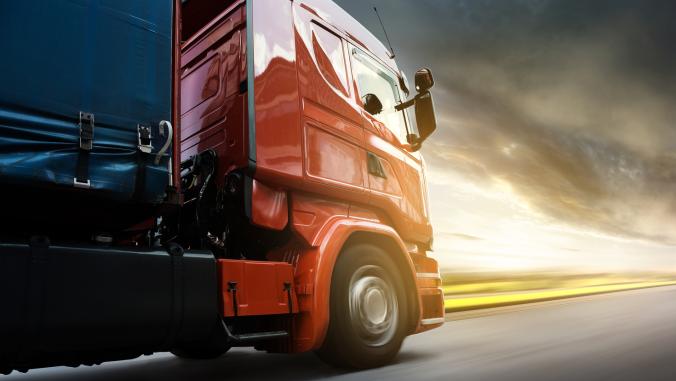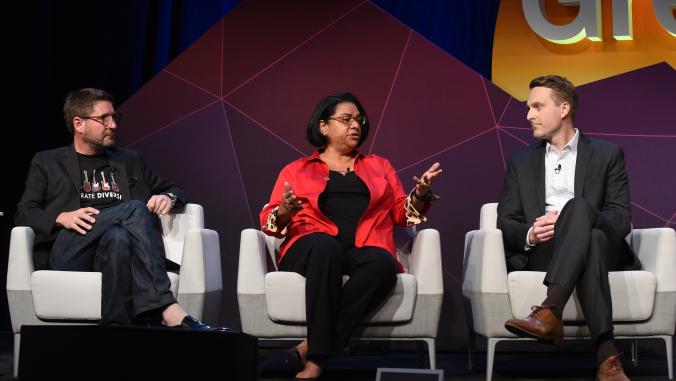8 ripple effects of the circular economy in 2017
From Apple to Cremona, Italy, to Unilever, here's how industry, agriculture and cities cleaned up their acts this year.

The effects of the circular economy — which swaps the "take, make, dispose" model for one in which resources are kept in play for as long as possible — spread far this past year.
"We have to radically change our attitude towards making things," Mark Miodownik, a materials scientist at University College London, told the Ellen MacArthur Foundation (EMF), an organization dedicated to helping implement the circular economy.
As civilization's production processes become more complex, he said, it's imperative to design ways to reclaim material. And as the world's population grows, a new industrial revolution is in order to preserve natural resources and keep toxic or non-biodegradable products from piling in landfills or leaching into the environment.
According to a 2017 McKinsey report, implementing the circular economy could save up to $711 billion annually and bring $2.13 trillion in economic boons in Europe alone. New technologies are emerging, too, to help companies transform the way they do business and create value from the circular economy.
Here's proof that cities, designers, manufacturers and more are detaching from the linear mine-to-landfill economy and embracing one that celebrates the preservation and exchange of materials — and ideas.
1. The circular city
The urban environment of the future will be circular. That doesn't mean the city grid will be shaped like an oval; what it does mean is that cities will be equipped with systems that divert waste into inputs for other people or processes.
The World Bank estimates that by 2025, urban residents will generate 2.2 billion tons of waste annually — but not if cities such as London, Beijing, Paris or even Ljubljana, Slovenia, have anything to do with it. These are all part of the Circular Cities Network, launched by 12 cities in 2016 with a pledge to apply circular approaches to urban challenges.
And in 2017, Google and the EMF launched a report on actionable steps cities can take to go circular, as well as four new technologies enabling the transition: the ability to tag and track the condition and availability of products or materials; information on the flow of materials; data aggregating patterns of human behavior; and connectivity enabling leasing and sharing platforms.
"A circular city aims to generate prosperity and economic resilience … while decoupling this value creation from the consumption of finite resources," said the report, which is already being implemented by New York City.
Other ways that the circular economy is showing up? Cars could become obsolete as ride-sharing companies such as Lyft or Uber, now household names, nix the need to purchase personal cars for intermittent use, or help reduce traffic by partnering customers into a carpool.
Cities such as London are promoting tool-sharing, like at the "Library of Things" in London, reducing the need for people to purchase electronics or appliances; and Mayor Sadiq Khan has stated that 65 percent of the city's waste, including food waste, will be recycled by 2030.
The 72,000-person town of Cremona, Italy, is a "test ground" for Italy's waste-reduction efforts as the country adopts the circular economy, in part because business leaders are endorsing the practice. In two years, Cremona increased the percentage of waste collected separately for recycling from 53 percent to 72 percent.
2. Materials as a service
Thanks to subscription-as-a-service technology, companies can sell access to a product without increasing manufacturing of the product itself.
Information technology company Hewlett-Packard (HP), for example, offers an "Instant Ink" subscription, which notifies the company when a printer cartridge is running low. HP then sends a replacement cartridge along with a postage-paid envelope to return the used one, which lowers the cost of buying a cartridge while rerouting them from the landfill.
(HP also partnered with Thread International to launch ink cartridges made from bottles recycled in Haiti, which creates jobs there and prevents plastic from polluting the Caribbean.)
And lighting company Philips is pivoting from selling light fixtures to providing its famous "Hue" lighting as a service.
With 5 billion new customers joining the market, the company's leadership "recognized that if the company wanted to be around for another 100 years, they needed to shift away from relying on extracting raw materials," said Thomas Singer, principal researcher in corporate leadership at the Conference Board. Philips retains ownership of the light fixture while customers purchase the service, maintenance, upgrades and "even the kilowatts," which not only reduces waste but helps the company learn about customers' needs and usage patterns.
3. Building layer by layer
The science-fiction fantasy of being able to print spare products that you need in the comfort of your home is becoming a reality, and it might help mitigate some of the worst effects of manufacturing, too. BSR reports (PDF) that 3D printing demonstrates that it has the potential improve resource efficiency and cut waste.
Researchers have developed a new system called upAM that grinds waste plastic into polymer filaments rivaling the quality of virgin material. While upAM isn't ready for industrial use, a startup called Markforged (backed by Siemens, Microsoft Ventures and Porsche SE) built a 3D printer for metals that can create car parts 60 percent lighter than traditionally manufactured ones, with no wasted shavings.
Siemens is investing in 3D printing technology with the aim of producing products that are lighter and easier to repair, increasing their durability. In February, it worked with British company Materials Solutions to print high-performing nickel alloy blades for wind turbines, which could hit the mass market within two years. It also printed repair parts for Slovenia's Krško nuclear plant.
Nike also has had its foot in the 3D printing game: By printing its FlyKnit shoes using only the necessary material, it decreased manufacturing waste for the product by 80 percent and announced a new line of 3D-printed shoes.
Recycling on the runway
The polluting "fast fashion" industry began to unravel in 2017. Clothing company C&A released the first line of T-shirts certified by the Cradle to Cradle standard, meaning they were designed and made to be recirculated back into industrial materials or composted at the end of their use.
The C&A Foundation launched the Fashion for Good platform with Kering as a partner, helping to catalyze more sustainable (and circular) production methods. Fashion for Good sponsored the "Plug and Play" accelerator, which promotes growth and knowledge-sharing of sustainable fashion startups.
Every second, the equivalent of one garbage truck of textiles is wasted, the EMF found. In November, designer Stella McCartney joined the foundation to help reduce the fashion industry's impact, with efforts endorsed by H&M, C&A, Nike and Lenzing.
Footwear manufacturer Timberland brought recycling to the runway: It worked with Thread International to launch a line of sneakers and boots whose fabric is made from recycled bottles from Haiti.
4. ZWTL
The environmentally "iffy" fragrance industry is, at least, setting a good track record on waste. In July, International Flavors & Fragrance (IFF) earned Zero-Waste to Landfill (ZWTL) status, which means it landfills no waste due to reducing, reusing, recycling and recovering energy from garbage.
Also this year, hardwood floor care company Bona achieved zero-waste at its North Carolina factory.
Communications and automotive services company Cox Enterprises has committed to send no waste to landfills by 2024 through a variety of efforts such as tire recycling, which addresses problems such as harboring disease-carrying mosquitoes and fires that produce toxic emissions.
It is joining well-known corporations such as Microsoft (which was zero-waste certified last year), P&G and Ford that have set historic landfill-free goals. Entire cities are circling this goal, as well: the UAE's Sharjah plans to reach ZWTL by 2020.
Not all companies are zeroing in on a timeline, but efforts are going in the right direction. In its latest environmental responsibility report, Apple claimed that it will use 100 percent recycled materials to make iPhones, Macbooks and other electronics in order to rely less on mining.
5. China's waste ban
Early next year, China is introducing a de-facto ban on imported plastic, electronic waste and mixed paper. This is throwing the U.S. recycling and manufacturing industry for a loop, as it's one of the largest exporters of scrap and waste going West.
But other companies see an opportunity to remodel the U.S. recycling industry and implement more closed-loop processes within manufacturing processes. A cross-industry collaboration between the Recycling Partnership and companies such as Target, Coca-Cola and Keurig aims to "automate" the use of up to 25 percent of recycled materials in industry.
It also could spur the widespread adoption of online material exchange platforms such as the Materials Marketplace. (By the way, zero-waste companies reported that they are generally unruffled by the risk posed by the risk posed by the trade ban.)
6. Marine plastic
Like a side of plastic with your fish and chips? The ocean contains 165 million tons of plastic, and if the current rate of production continues, it may hold more plastic than fish by 2015, according to the World Economic Forum.
The "New Plastics Economy" initiative it launched with EMF early in 2017 urged companies to replace polystyrene (PS), expanded polystyrene (EPS) and polyvinyl chloride (PVC) as packaging materials globally, bringing attention to the massive impact of common goods such as takeout packaging. Crumbled EPS foam is commonly found in beach cleanups and the bellies of birds and fish. Amcor, Danone, L'Oreal are among more than a dozen companies following the initiative's recommendations.
The United Nations presented recycling company TerraCycle with an award this year for working with P&G on the "Ocean Plastic Bottle," the first commercially available consumer-grade bottle made from 10 percent marine plastic and 90 percent recycled plastic.
7. Feeding a waste-free culture
An "internet of things" for food is helping to reduce waste going to landfills. Swedish furniture manufacturer IKEA publicized a goal to halve food waste from its restaurants and cafes by 2020. To do this, it's training employees to measure the value of potentially wasted food with tools made by technology partners LeanPath and Winnow.
Food services provider Aramark also set a goal of reducing food waste by 2030 from its 2015 baseline by integrating LeanPath's tracking and analytics technology platform.
Farmers, chefs and entrepreneurs globally are enjoying the global growth of smaller-scale food waste startups that are helping fight hunger and climate change at the same time while contributing to a new sector of the economy.
And in cities, urban agriculture cooked up new ways to use city spaces and limited resources to grow food, green communities and provide food access and jobs to low-income residents. The combination of data, technology and initiative has made the perfect recipe to cultivate the circular economy.





